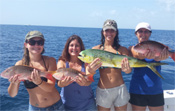 |
|
||
 |
||
 |
||
 |
||
|
Charter Fishing off of Hobe Sound/Stuart, Florida Catching Cobia and Snapper
Interesting Facts About Cobia FishThe cobia, Rachycentron canadum, is a fairly common offshore finfish species, highly prized by both recreational and commercial fishermen. They are excellent table-fare and usually appear on everyone’s list of favorite fish to eat. Cobia are the only living species in their family and they have no close relatives. Found almost worldwide in tropical, subtropical and warm temperate waters, they are open-water fish, but tend to locate around pilings, buoys or drifting objects. They even orient themselves under sea turtles and floating boats. Cobia also appear to be attracted to noise. They range from saline bays inshore to offshore waters 4,000 feet deep. They are found over mud, sand, and gravel bottoms, over coral reefs and in mangrove sloughs. In the Gulf of Mexico, cobia winter in the Florida Keys and move north and west along the Gulf coast to Louisiana and Texas in the spring. The cobia fishery reflects these migratory habits. In south Florida, cobia are fished mostly in the winter. Off of Louisiana, the fishery takes place in spring and summer. Some research indicates that cobia also move offshore to deeper waters during cooler months. Male cobia mature earlier than females, at 21 inches and 2.5 pounds in their second year. Females begin to mature in their third year at 27 inches and about 7 pounds. Cobia form spawning groups in the northern Gulf of Mexico between May and August. Egg counts made from 6 females from the Atlantic Coast ranged from 1.9 to 5.4 million eggs per female. Fertilized eggs are buoyant and are kept afloat by a large oil globule in the egg until they hatch in 36 hours. Highest hatching rates occur in full-strength seawater at temperatures of 80°F. Cobia grow rapidly, reaching 7 inches in a matter of months and 13 to 15 inches by one year old. Cobia are known to live at least 10 years and may reach 15 years of age. The world record for rod-and-reel-caught cobia is a 135 pounder from Australia, although 150-pound fish have been reported.
|
 |
 |
 |
Cobia and Snapper Caught Fishing off of Hobe Sound/Stuart Florida |
 |
 |


